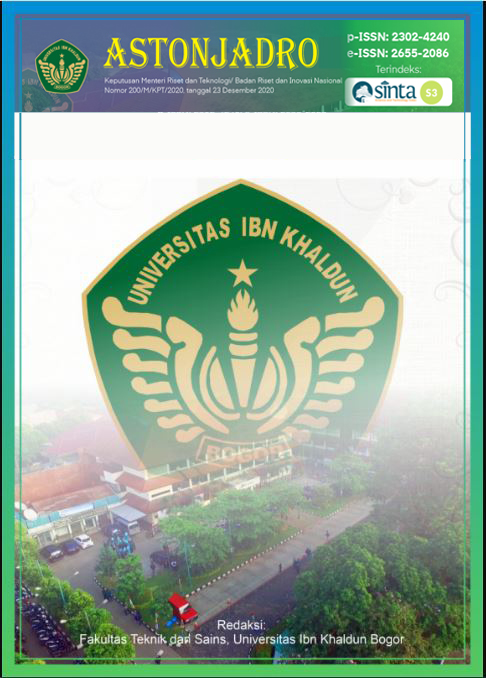Ciliwung River Normalization Analysis using HEC-RAS Application (TB. Simatupang Bridge to Bidara Cina)
DOI:
https://doi.org/10.32832/astonjadro.v12i1.7796Keywords:
flood, river normalization, HEC-RAS, hydraulic, river cross.Abstract
Ciliwung River area which starts from TB. Simatupang Bridge to Bidara Cina is one of the areas that experienced severe flooding.This is caused by changes or conversion of land functions which were originally a water catchment area into settlements. Buildings that stand along the river body makes the current cross section of the Ciliwung River unable to function optimally in accommodating flood discharges. In addition, there is no public awareness in protecting the environment, it can be seen from the large piles of garbage on the riverside of the Ciliwung River.One of the efforts made by the government in flood control is river normalization, but in practice the normalization of the Ciliwung River can be said to be not running optimally. The purpose of this research is : the Author want to know how big the capacity of Ciliwung River existing cross section (starting from TB Simatupang Bridge to Bidara Cina) using Hec-Ras software application to modeling the river's cross section existing and so does recording and mapping ofpotentialflood locations. Based on the hydrology calculation, known that flood discharge plan Q25is 404.3m3/s, while the hydraulic Q is only 79.03 m3/s, the Q total is 483,38 m3/s. The results of modeling using the Hec-Ras river cross section existingcannot accommodate the planned flood discharge so that river normalization efforts are needed. Recording and mapping flood locations are useful to get the effectivity of River's normalization according to flood controlling at Ciliwung River (specific at TB Simatupang Bridge to Bidara Cina).
References
Balai Besar Wilayah Sungai Ciliwung Cisadane, 2013, Review Desain Normalisasi Kali Ciliwung, Jakarta.
Hadisusanto, Nugroho. 2011. Aplikasi Hidrologi. Malang: Jogja Media Utama.
Istiarto, 2014, Simulasi Aliran 1 – Dimensi Dengan Bantuan Paket Program Hidrodinamika Hec-Ras, Yogyakarta.
Kodoatie, Robert.J., dan Sugiyanto. 2001. Banjir: Beberapapenyebab dan metodepengendaliannya. Yogyakarta: Pustaka Pelajar.
Suripin. 2004. Sistem Drainase Perkotaan yang Berkelanjutan. ANDI Offset Yogyakarta.
Standar Nasional Indonesia 2415, 2016. Tata Cara Perhitungan Debit Banjir Rencana. Jakarta.
MP Alam, M Lutfi, 2016. ANALISIS TREND HIDROGRAF TERHADAP SIMULATOR HUJAN SATU MODEL DAS DENGAN METODE HSS GAMA I. ASTONJADRO 5 (2), 58-66.
I Satriadi, 2017. ANALISIS HIDROGRAF BANJIR SALURAN IRIGASI CIBALOK. ASTONJADRO 6 (1), 49-59.
MI Imamuddin, L Laraswati, 2021. ANALYSIS CAPACITY OF WATERWAY IN ANEKA ELOK EAST JAKARTA. ASTONJADRO 10 (2), 322-332.
B Barid, BO Afanda, 2022. Increasing peak flow of snyder synthetic hydrograph units in the serenan sub-watershed of Bengawan Solo Watershed. ASTONJADRO 11 (3), 616-626.
LPGA Parwati, NKA Dwijendra, NK Agusintadewi, 2022. IMPACT OF ABRATION ON LAND USE IN COASTAL AREA BULELENG REGENCY. ASTONJADRO 11 (2), 319-325.
GYD Astuti, F Hariati, 2016. STUDI KARAKTERISTIK ALIRAN PADA FLUME SALURAN TERBUKA DI LABORATORIUM TEKNIK SIPIL UIKA. ASTONJADRO 5 (1), 16-26.
AF Hasibuan, F Hariati, 2017. PERENCANAAN SISTEM PERPIPAAN AIR BERSIH KELURAHAN ABADI JAYA KECAMATAN SUKMAJAYA KOTA DEPOK. ASTONJADRO 6 (2), 69-78.
MZ Suhadi, I Namara, 2017. PERENCANAAN TEKNIS PEMBANGUNAN PRASARANA SANITASI (STUDI KASUS PEMBANGUNAN PRASARANA SANITASI DI KAMPUNG CIKUKUL DESA NAGRAK SELATAN KABUPATEN SUKABUMI). ASTONJADRO 6 (1), 60-69.
SN Farodhiyah, N Chayati, 2016. NILAI KERUGIAN BANGUNAN RUMAH TINGGAL AKIBAT BANJIR PASANG DI MUARA BARU (Studi kasus: Kelurahan Penjaringan, Kota Jakarta Utara). ASTONJADRO 5 (2), 24-34.
M Imamuddin, D Cahyanto, 2020. ANALYSIS OF DRAINAGE CHANNEL CAPACITY AT SINDANG STREET IN SINDANG HOUSE PUMP AREA. ASTONJADRO 9 (2), 132-144.
Downloads
Published
How to Cite
Issue
Section
License
Copyright (c) 2022 ASTONJADRO

This work is licensed under a Creative Commons Attribution-ShareAlike 4.0 International License.
Paper submitted to ASTONJADRO is the sole property of the Astonjadro Journal. Unless the author withdraws the paper because he does not want to be published in this journal. The publication rights are in the journal Astonjadro.ASTONJADRO
LICENSE
This work is licensed under a Creative Commons Attribution-ShareAlike 4.0 International License.
Based on a work at http://ejournal.uika-bogor.ac.id/index.php/ASTONJADRO













